Originally published by CAFA Art Info
人类有多惧怕疾病和死亡?个体的疾病与死亡不仅仅是人类生命体内的破坏与终结,也与生命系统的环境变化和发展有着紧密的联系。自二十世纪以来人类在创造奇迹的同时也在制造着灾难,人类社会物质财富迅猛增长,而与此同时人类对于自然和生物环境的破坏也无以复加。
How much do people fear diseases and death? An individual’s disease and death do not just mean the destruction and end of human life, but also have a close relationship with the environmental changes and development of living systems. Since the 20th century, people have been creating miracles while also bringing about disasters. The material wealth of society has grown rapidly, but meanwhile the manmade damages to the natural and biological environment also repeatedly occur.
尽管疾病伴随着人类的生活,痛苦却让我们真实地感觉活着并在某种意义上证明了我们的存在。正是在思考疾病、研究疾病、惧怕灾难和逃避死亡的探索中, 人类致力于去寻求慰籍与治愈。伴随着人类文明的发展,艺术家们敏锐地提供了各种各样表现疾病及其内涵的创作,进而警示人类行为并探讨人类治愈这样的普世主题。
Although diseases have always accompanied human life, pain makes us feel alive and, in a sense, proves our existence. It is through the exploration of thinking about diseases, studying diseases, and fearing disasters while avoiding death that people are committed to seeking comfort and healing. Along with the development of human civilisation, artists have keenly provided a variety of creations portraying diseases and their connotations, and further give us a profound warning regarding human behaviour while exploring such a universal topic as healing.
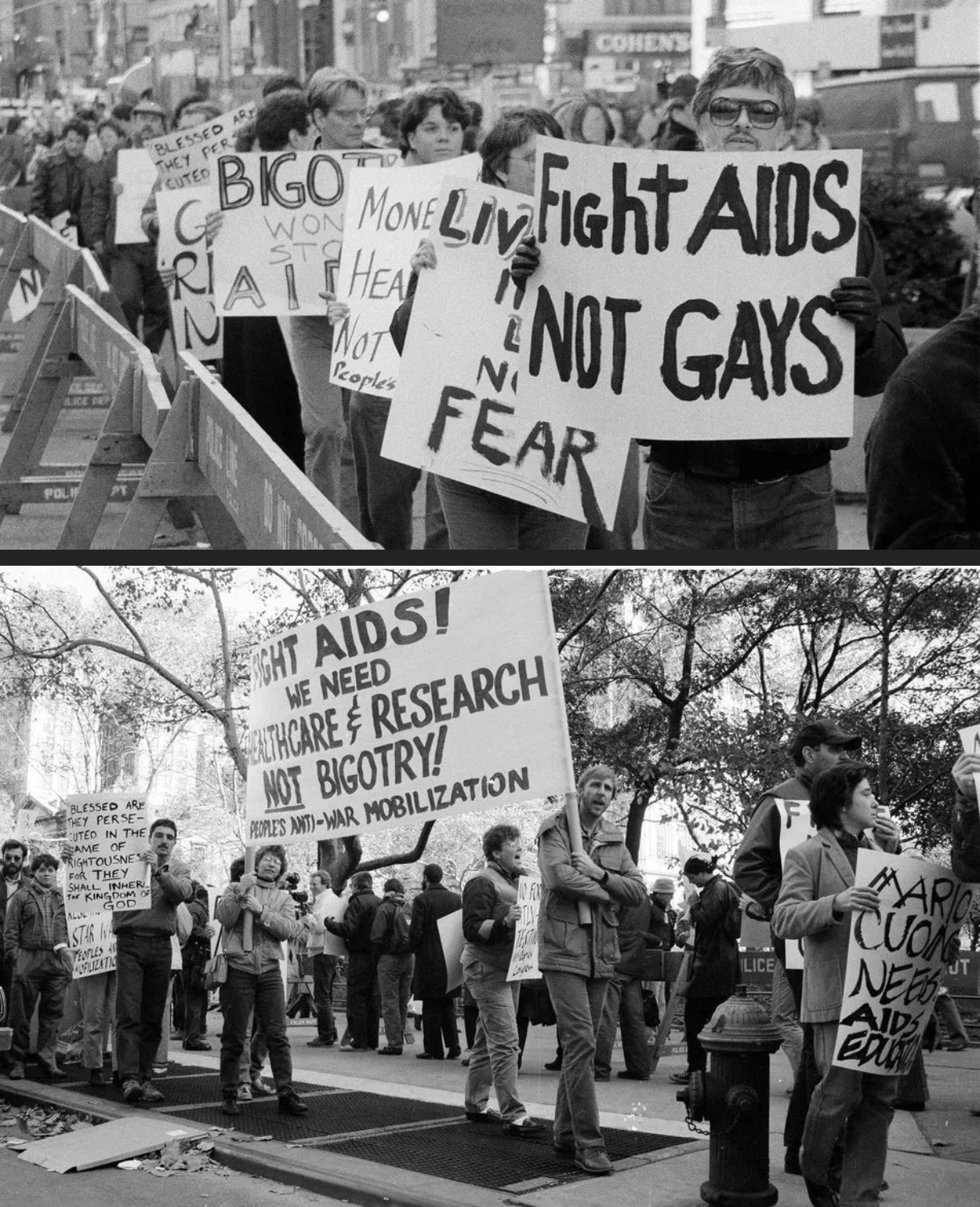 Images: 1985年11月15日 纽约市政厅附近的示威游行者抗议市政厅考虑立法禁止携带艾滋病毒的师生进入公立学校。Demonstrators protest near New York City’s City Hall on Nov. 15, 1985, as City Council committee considered legislation to bar students and teachers with the AIDS virus from public schools. IMAGE: APAP PHOTO/RICK MAIMA, Source: https://mashable.com/2016/10/26/aids-epidemic-study/
Images: 1985年11月15日 纽约市政厅附近的示威游行者抗议市政厅考虑立法禁止携带艾滋病毒的师生进入公立学校。Demonstrators protest near New York City’s City Hall on Nov. 15, 1985, as City Council committee considered legislation to bar students and teachers with the AIDS virus from public schools. IMAGE: APAP PHOTO/RICK MAIMA, Source: https://mashable.com/2016/10/26/aids-epidemic-study/
谈到疾病对当代艺术的影响,艾滋病危机是无法回避的话题。二十世纪七十年代艾滋病(AIDS)从加勒比海地区(Caribbean)传入美国纽约并在其后的十年间就带走了几十万生命。理查德·彭斯,曾在1986年至2009年之间担任美国纽约LGBT团体中心负责人(Lesbian, Gay, Bisexual & Transgender), 他在Mashable于2016年进行的相关报道中[1],表示二十世纪八十年代的纽约感觉像是处于战区,“你会感觉那时的生活伴随着恐惧、不断的死亡、彼此看护、还有战斗疲劳症”。
When it comes to the impact of diseases on contemporary art, the AIDS crisis is an unavoidable topic. In the decade after AIDS “jumped” from the Caribbean to New York City in 1970 or 1971, hundreds of thousands of US lives were taken by the disease of human immunodeficiency virus (HIV). Richard Burns, who was the Executive Director of the New York City LGBT Community Center from 1986 through 2009, told Mashable that New York City in the 1980s felt like a war zone: “you were living with fear and constant dying and caregiving and shellshock.”
早在卫生机构认识到艾滋病危机之前,艺术家们就开始引发人们对这一问题的关注。在二十世纪八十年代的文化背景下,有关艾滋病这一有争议性的主题也在艺术圈内引发了广泛的讨论并成为艺术家为少数群体争取同等权益的触发点,从此人们逐渐意识到:艺术也可以参与社会问题的对话,并且产生不可小觑的影响力。
Even before health institutions recognised the AIDS crisis, artists started drawing attention to the issue. Art that started to concentrate on this controversial theme emerged from a broader cultural community in the 1980s. The questions about AIDS opened significant debates and they later triggered activities to fight for equal rights of minorities. Since then, people have gradually realised that art can also participate in the dialogue of social issues, and they further exert some significant influence.
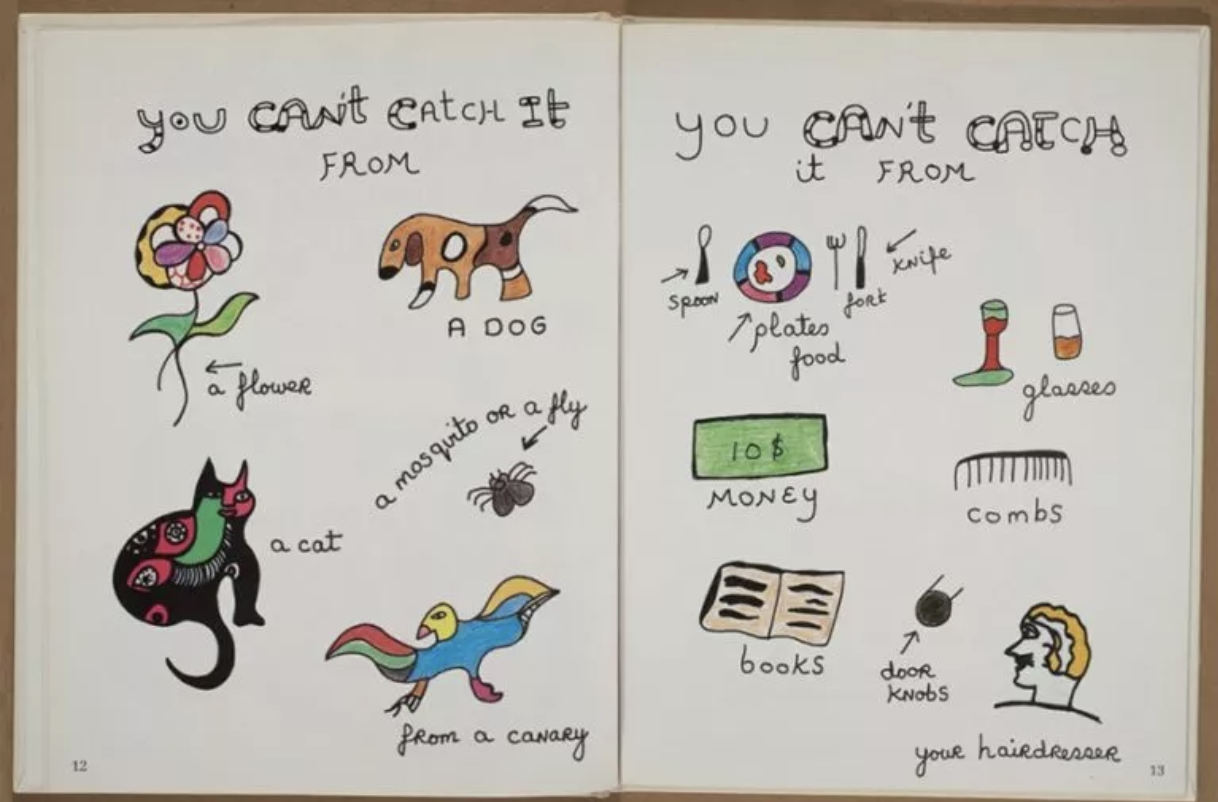 Image: 妮基·桑法勒为艾滋病主题创作的艺术家手制书 , Niki de Saint Phalle – AIDS, you can’t catch it holding hands, 1987, book. Photo via artnews.com
Image: 妮基·桑法勒为艾滋病主题创作的艺术家手制书 , Niki de Saint Phalle – AIDS, you can’t catch it holding hands, 1987, book. Photo via artnews.com
直到1985年美国总统里根才在公众演讲中第一次提到了“AIDS” ,由于起初公众都不了解病毒来源和传播方式,艾滋病传播的危机让许多艺术家和创作者都在不知不觉中身陷疾病,凯斯· 哈林(1958-1990)也是其中之一。疾病并没有使他消沉沮丧,他创建了凯斯· 哈林基金会并为艾滋病研究治疗和儿童福利做努力,同时继续艺术创作直至生命终结,正如他在日记中所表达的,“你所做的一切都是一种对永生的追求,因为你在创造这些你知道有不同生活的东西,它们不依赖于呼吸,所以它们的寿命比我们任何人都长,它们在某种程度上延长了你的寿命。” [2]
It was not until 1985 that US President Reagan mentioned “AIDS” in a public speech. Since the majority of public did not understand the source and transmission of the virus in the decade before that, many artists and creators had been affected by the crisis, Keith Haring (1958-1990) was one of them. Although he felt frustrated because of the disease, he did not fall into a depression; instead, he founded the Keith Haring Foundation contributing to AIDS research and therapy as well as children’s welfare. He kept working on art until the end, as he wrote in his diary, “all of the things that you make are a kind of quest for immortality. Because you’re making these things that you know they have a different kind of life. They don’t depend on breathing, so they’ll last longer than any of us will. Which is sort of an interesting idea, that it’s sort of extending your life to some degree.”
 Images: 凯斯· 哈林 《无视=畏惧》(1989), Keith Haring, “Ignorance = Fear” (1989), Courtesy of the Keith Haring Foundation
Images: 凯斯· 哈林 《无视=畏惧》(1989), Keith Haring, “Ignorance = Fear” (1989), Courtesy of the Keith Haring Foundation
艾滋病流行所产生的社会危机感成为了二十世纪八十年代很多美国艺术家创作的主题,并且极大地改变了当代艺术世界。“愤怒、困惑、恐惧和蔑视,一切皆由艺术家的生存现状和文化的兴起所激发,既是对危机的一种回应,也很大程度上改变了主流自我反省式的艺术创作手法,使艺术更接近政治和生活。” [3]
The AIDS epidemic crisis became the topic of artworks in the 1980s by many American artists using diversified methods and transformed the world of contemporary art significantly. “Anger, confusion, fear and defiance, all triggered by the artists’ existential situation and the emergence of culture which formed a response to the crisis, having immensely changed the dominant self-reflexive art practices, bringing art closer to politics and life.”
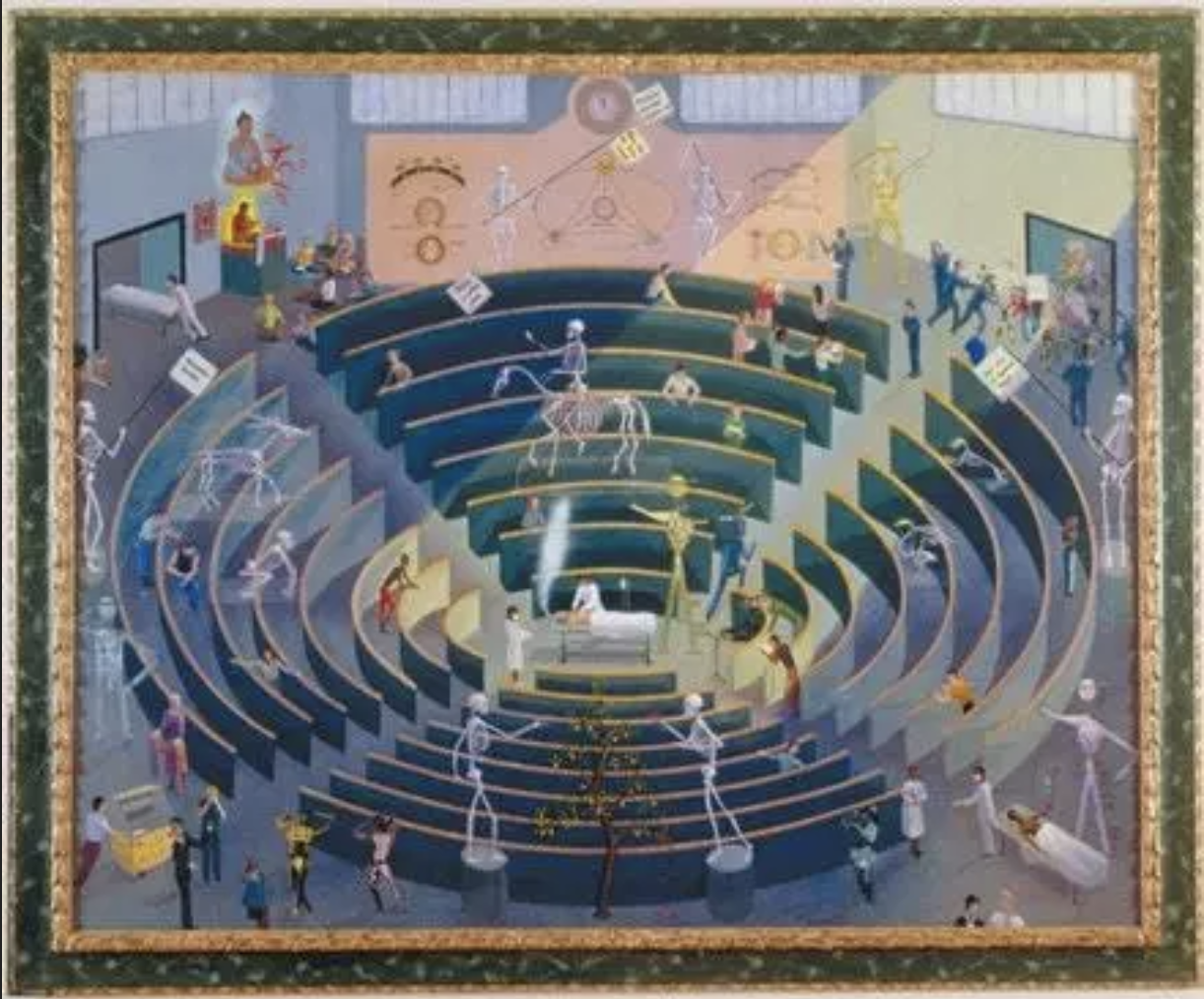 Image: 弗兰克·摩尔 《竞技场》(1992) 木板布面油彩丝网, Frank Moore, “Arena,” 1992. Oil and silkscreen on canvas mounted on wood, in antique gilded frame. 61 x 72”. Collection of Gian Enzo Sperone, Sent, Switzerland. Image: Courtesy Sperone Westwater, New York.
Image: 弗兰克·摩尔 《竞技场》(1992) 木板布面油彩丝网, Frank Moore, “Arena,” 1992. Oil and silkscreen on canvas mounted on wood, in antique gilded frame. 61 x 72”. Collection of Gian Enzo Sperone, Sent, Switzerland. Image: Courtesy Sperone Westwater, New York.
美国艺术家弗兰克·摩尔(1953 – 2002)在作品中描述了DNA重组、人体工程学和基因组合等等意象并表现了他所处的炼狱般现实(艾滋病感染者)和他对地狱的想象,正如他所述,“尽管我们现代的世外桃源看起来如此美丽,但这是融合了现代生活所有复杂性和毒性的美丽。”[4]
Frank Moore (1953 – 2002) portrays a brilliant parade of DNA manipulations, human engineering and genomes in his work, with which he conveyed the reality of his purgatory and his own dream of hell, on which he stated that, “as beautiful as our modern Arcadia may appear to be, it is a beauty that is alloyed with all the complexities and toxicities of modern life.”
于是当人类践踏着无可再生的资源破坏和其他动物的残骸,昂首阔步迈进21世纪的“美丽新世界”时,这“复杂性和毒性”仍在蔓延。除了人类尚未完全克服的疾病外,我们还面临着更多的威胁和挑战。
These complexities and toxicities are still spreading as humans trample on the destruction of non-renewable resources and the remains of other animals and stride into the “brave new world” in the 21st century. In addition to the diseases that human beings have not completely overcome, we are constantly confronted with more threats and challenges.
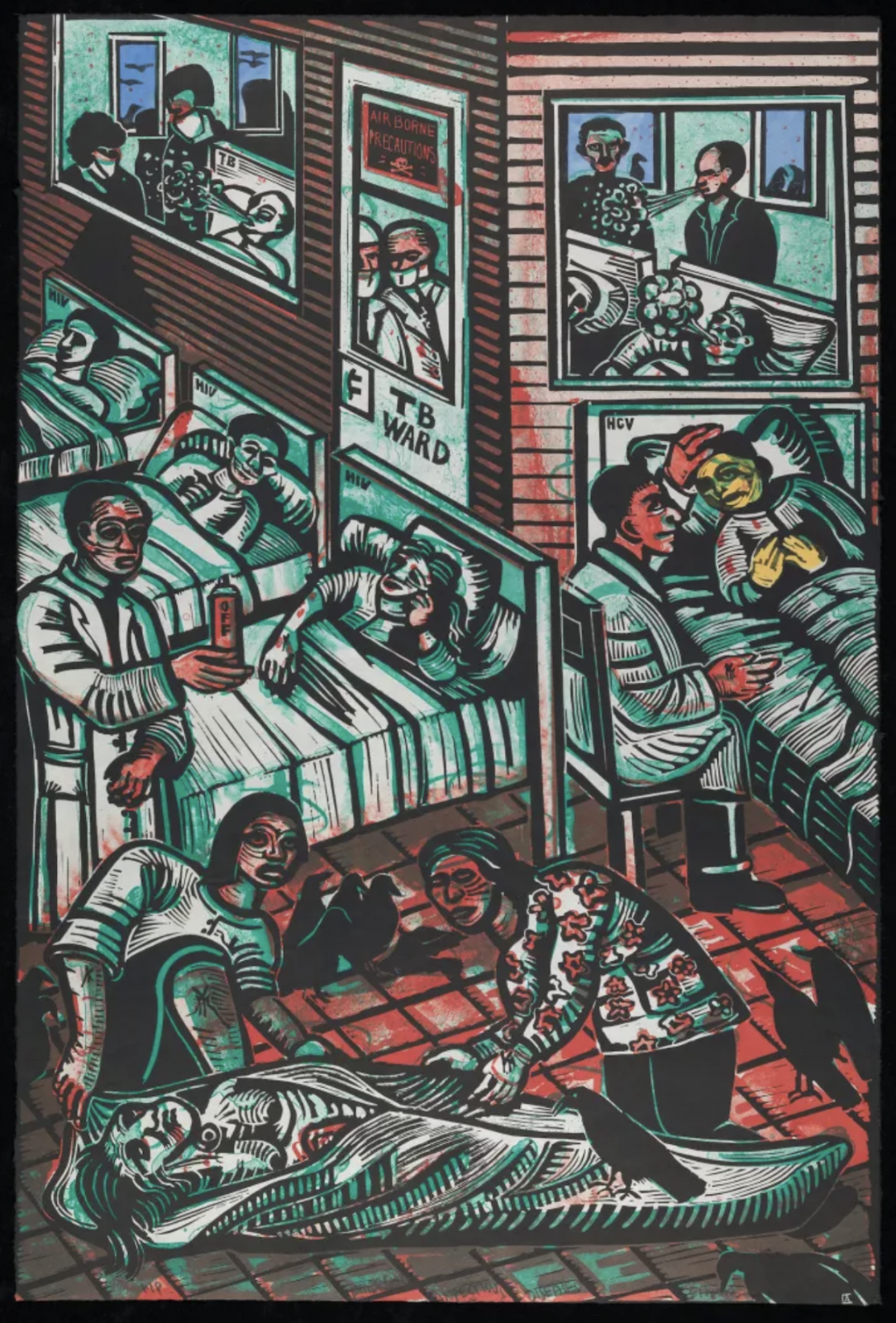 Image: 埃里克·艾弗里 《新兴传染病》(2000) 石版套麻胶版画 Eric Avery, “Emerging Infectious Diseases” (2000), linoleum block print over lithograph (Department of Rare Books and Special Collections, Graphic Arts Collection, Princeton University Library © Eric Avery)
Image: 埃里克·艾弗里 《新兴传染病》(2000) 石版套麻胶版画 Eric Avery, “Emerging Infectious Diseases” (2000), linoleum block print over lithograph (Department of Rare Books and Special Collections, Graphic Arts Collection, Princeton University Library © Eric Avery)
美国普林斯顿大学美术馆近期的展览《健康的状态:设想疾病与治愈》(2019年11月2日至2020年2月2日)纵观历史和多元文化,呈现了从上古到现今关于疾病与治愈的八十余件全球性艺术作品。[5]其中埃里克·艾弗里的作品 《新兴传染病》刻画了围绕流行病和传染病的社会焦虑,生与死转瞬切换的距离,发人深醒。
The recent exhibition throughout history and across cultures, entitled State of Health: Visualizing Illness and Healing (November 2, 2019 through February 2, 2020) presented by the Art Museum of Princeton University, featured over 80 works of globe-spanning art. “Emerging Infectious Diseases” (2000) by Eric Avery examines the societal anxiety about pandemics and infectious disease, the instantaneous switching between life and death, which has a sobering connotation.
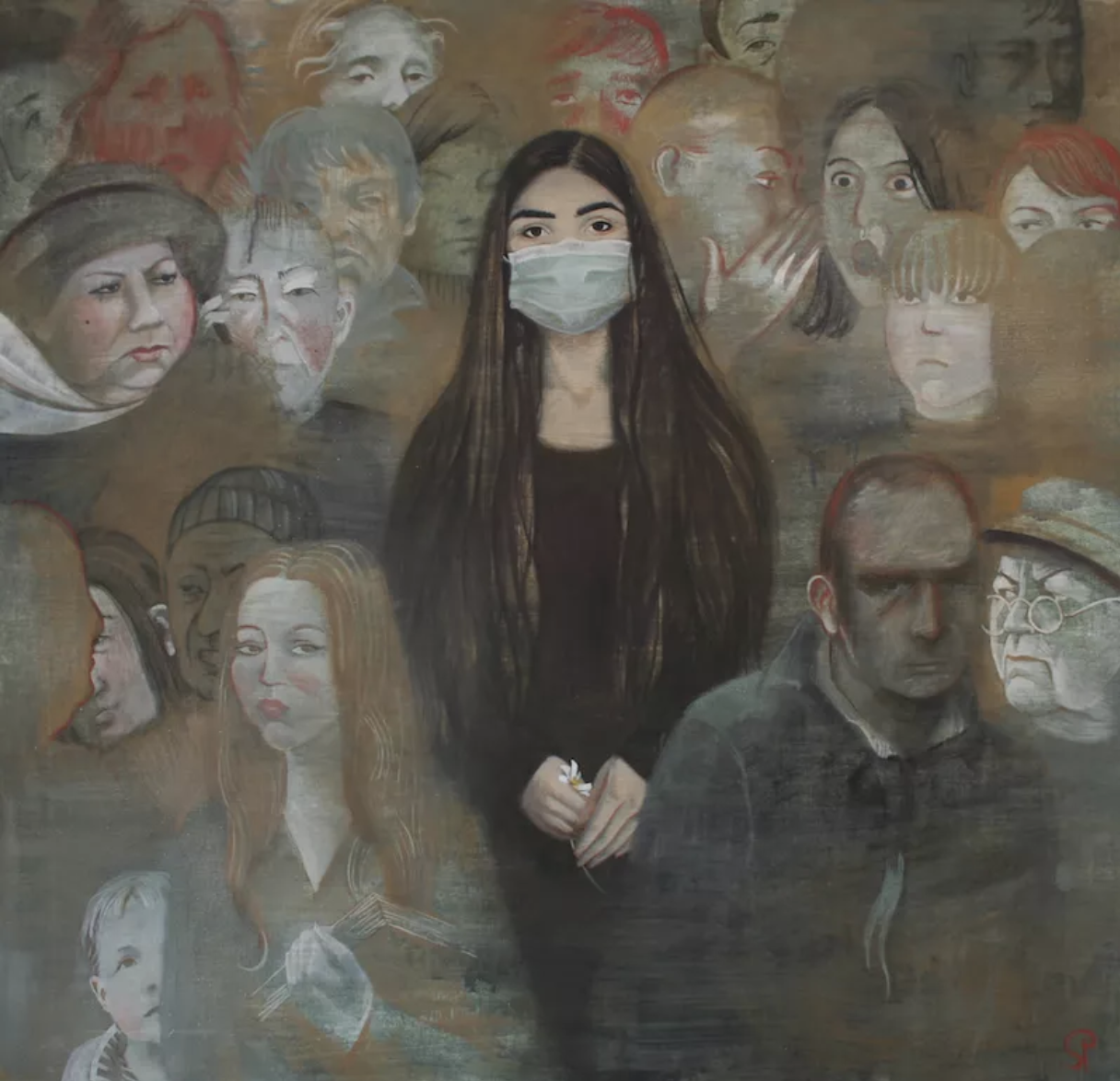 Image: 俄罗斯艺术家宝琳娜 《屏住呼吸》 曾于2017年3月24日(世界肺结核日)在世界卫生组织日内瓦总部展出。 Russian artist Paulina Siniatkina, “Hold Your Breath”, was exhibited at the headquarters of the World Health Organization (WHO) in Geneva on 24 March 2017 (World TB Day).
Image: 俄罗斯艺术家宝琳娜 《屏住呼吸》 曾于2017年3月24日(世界肺结核日)在世界卫生组织日内瓦总部展出。 Russian artist Paulina Siniatkina, “Hold Your Breath”, was exhibited at the headquarters of the World Health Organization (WHO) in Geneva on 24 March 2017 (World TB Day).
对于受疾病启发而进行创作的当代艺术家们来说,“感恩胜于痛苦”。2015年俄罗斯艺术家宝琳娜在莫斯科的结核病医院度过了6个月17天,在这个过程中她经历了恐惧、误解、愤怒、绝望、孤独、沉默、爱、友情和希望。[6]《屏住呼吸》系列作品讲述了她和遭遇相似病况其他病人的故事,也是她对抗疾病的武器并以此敦促人们不要畏惧耻于谈论结核病才能更有效地阻止疾病蔓延。
For artists who have been inspired by illness, “gratitude outweighs pain”. In 2015, Russian artist Paulina Siniakina spent six months and 17 days in a TB clinic in Moscow. She went through fear, misunderstanding, anger, despair, loneliness, silence, love, friendship, and hope. Her “Hold Your Breath” series tells stories of herself and other people who shared her fate, which she takes as a weapon to fight the stigma of disease and urges people not to be afraid to talk about TB.
美国艺术家迪伦· 莫蒂默经历了两次双肺移植手术,他曾患有囊性纤维化,疾病使得他呼吸困难而艺术成为他处理和探索疾病的方式。迪伦· 莫蒂默由肺和身体细胞的结构图形受到启发进行创作,每一件作品都承载着他痛苦的重量,但他依然很乐观地说,“我相信在最绝望的情况下仍有希望,这也当然是我还活着的原因。” [7]
American artist Dylan Mortimer has endured two double lung transplants during his life. Cystic fibrosis clogged his lungs, making him feel it is hard to breathe, but art has become a way for him to process and explore his disease. Inspired by the structure of lungs and cells of his body, he creates with their patterns and shapes, yet every piece holds the weight of his pain. He still believes that “there is hope in the most hopeless situations, that’s certainly what has kept me alive.”
 Image: 迪伦· 莫蒂默 《升》(2016);右:迪伦· 莫蒂默 《带来和解的拒绝》(2019) From left: “Ascension” by Dylan Mortimer, 2016; “Rejection that Brings Reconciliation” by Dylan Mortimer, 2019(COURTESY OF DYLAN MORTIMER)
Image: 迪伦· 莫蒂默 《升》(2016);右:迪伦· 莫蒂默 《带来和解的拒绝》(2019) From left: “Ascension” by Dylan Mortimer, 2016; “Rejection that Brings Reconciliation” by Dylan Mortimer, 2019(COURTESY OF DYLAN MORTIMER)
除了从自身的经历出发,还有更多的国际艺术家从科学和医学的视角,探索并质疑人类与细菌、病毒和传染病的关联,以及生物学研究和新科技的干预。
In addition to starting from their own experiences, there are more international artists using scientific and medical perspectives, exploring and questioning the relationship between humankind to bacteria, viruses, and infectious diseases, as well as the interventions of biological research and new technologies.
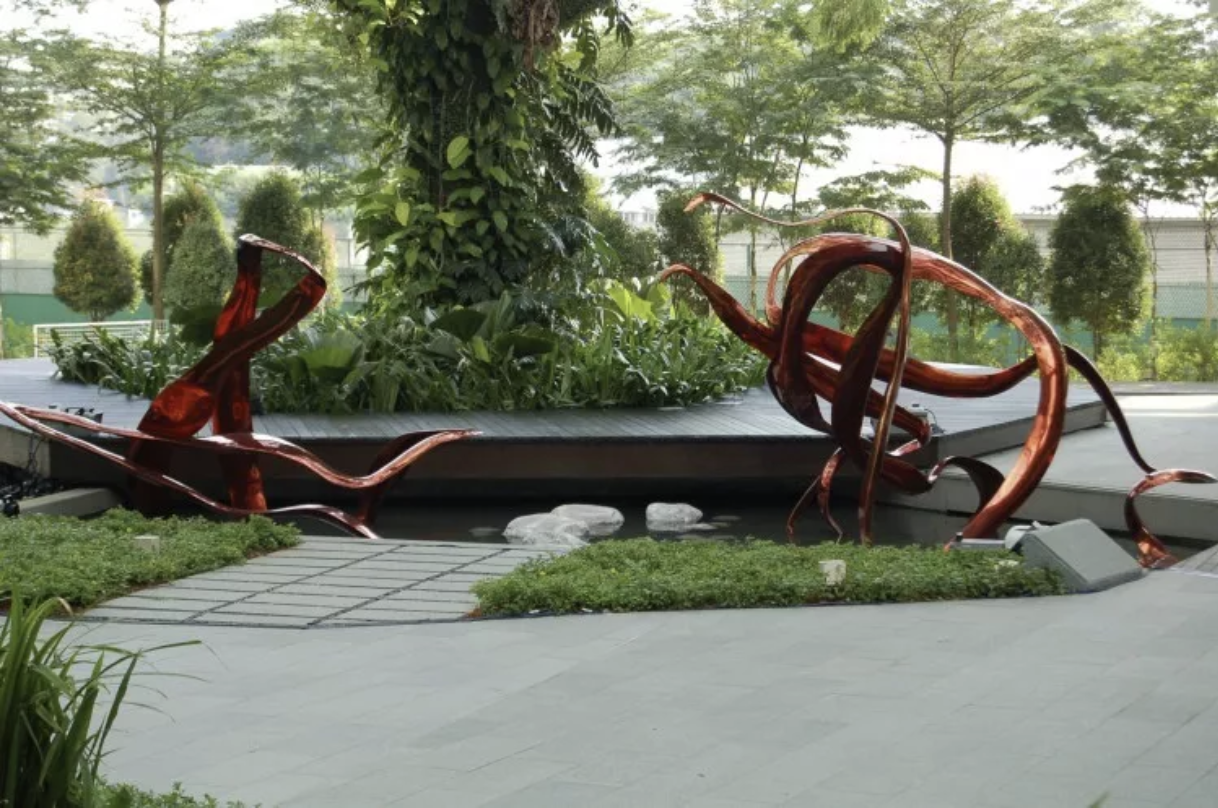 Photo: 玛拉·哈瑟汀《抑制非典》(2006) “SARS Inhibited” Materials: bronze, paint, rocks. Dimensions: 30′ wide, 9′ tall ©Mara G. Haseltine
Photo: 玛拉·哈瑟汀《抑制非典》(2006) “SARS Inhibited” Materials: bronze, paint, rocks. Dimensions: 30′ wide, 9′ tall ©Mara G. Haseltine
新加坡的启奥生物医药园中Epi-Center前永久矗立着由玛拉·哈瑟汀设计的雕塑作品《抑制非典》(2006)。这件室外雕塑为纪念在启奥生物医药园工作的国际科研团队发现SARS蛋白酶抑制剂而特别制作。非典SARS事件是指向于2002年在中国广东发生至2003年中期在中国北京逐渐被消灭的传染病疫潮。这件雕塑作品以拟态的形式生动地在艺术表达中结合生物科技概念,使治愈的希望与周围环境自然融合。
A bronze sculpture entitled “SARS Inhibited” (2006) by Mara G. Haseltine permanently stands in front of the Epi-Center of Biopolis in Singapore. This outdoor sculpture was created to memorise the functions of the SARS Protease Inhibitor discovered by the international team of scientists working at Biopolis. In a mimetic form, it vividly integrates biotechnology with artistic expression, hope of healing with surrounding environment.
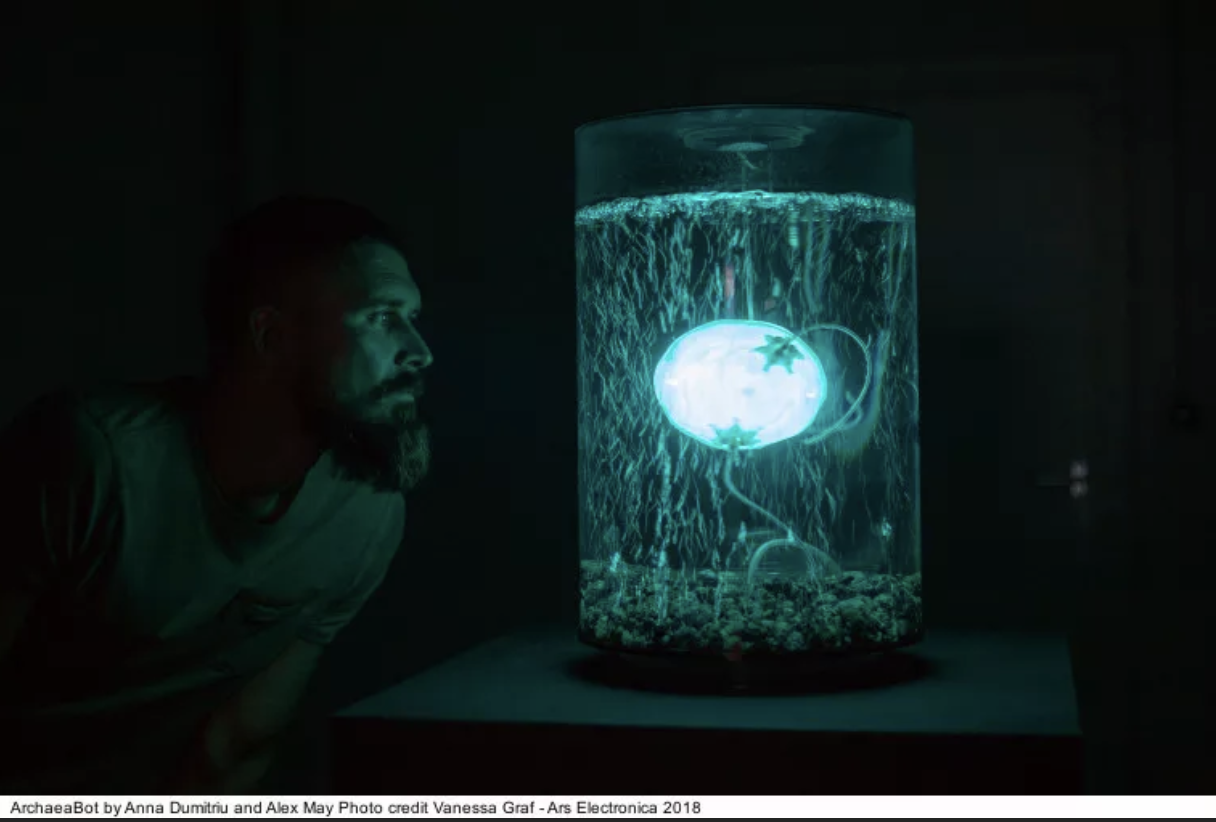 Photo: 安娜·杜米特和亚力克斯·梅 《古菌机器人:以个后奇点与后气候变化生命》(2018) ArchaeaBot by Anna Dumitriu and Alex May, Photo credit Vanessa Graf at Ars Electronica 2018 Source: http://digicult.it/articles/an-engagement-with-bacteria-interview-with-anna-dumitriu/.
Photo: 安娜·杜米特和亚力克斯·梅 《古菌机器人:以个后奇点与后气候变化生命》(2018) ArchaeaBot by Anna Dumitriu and Alex May, Photo credit Vanessa Graf at Ars Electronica 2018 Source: http://digicult.it/articles/an-engagement-with-bacteria-interview-with-anna-dumitriu/.
英国牛津大学现代化医学微生物学项目的驻地艺术家,英国艺术家安娜·杜米特的创作涵盖雕塑、装置、织物和生物学创作, 在作品《古菌机器人:以个后奇点与后气候变化生命》(ArchaeaBot: A Post Singularity and Post Climate Change Life-form)中安娜·杜米特和亚力克斯·梅以幽默诙谐的方式想象和创作人类对抗未来灾难性炎热环境效应的方式。[8]
As an artist-in-residence with the Modernizing Medical Microbiology Project at the University of Oxford, Anna Dumitriu’s creations span sculpture, installation, textiles, and biological work. With “ArchaeaBot: A Post Singularity and Post Climate Change Life-form,” Anna Dumitriu and Alex May imagine and prepare humans for a way of living to battle the catastrophically scorching umwelt.
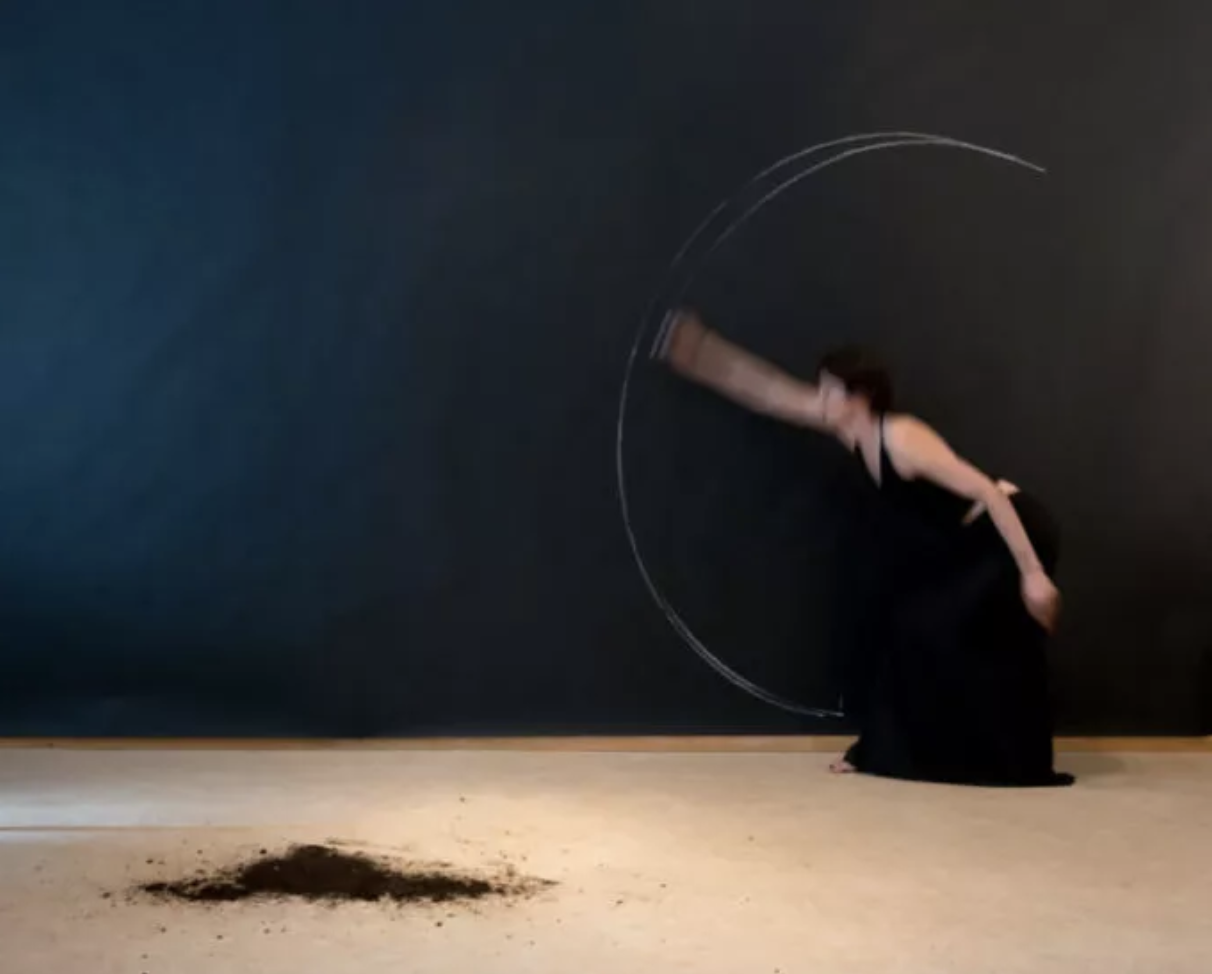 Photo: 玛格丽塔·佩弗 《互联系统的剖析》(2017) “Anatomy of an Interconnected System” (2017). Performative lecture (Media: animal bones, blackboard, chalk, soil, cotton cloth, animal blood, caput mortum pigment. Duration: 2 h 30′). Source: www.margheritapevere.com
Photo: 玛格丽塔·佩弗 《互联系统的剖析》(2017) “Anatomy of an Interconnected System” (2017). Performative lecture (Media: animal bones, blackboard, chalk, soil, cotton cloth, animal blood, caput mortum pigment. Duration: 2 h 30′). Source: www.margheritapevere.com
从人类的健康与生存,再到人类与环境的共存与治愈,生物科技的参与和干预,艺术不仅为人类提供了丰富多样的阐释,还提出了更多的可能与设想。疾病并不可怕,可怕的是缺乏勇气与想象力。无论是身体还是心灵的治愈,无论是弱势群体的权益还是整个人类和地球的未来,皆因艺术的参与而获得更加深刻的理解并唤起更多的关注和反思。
From the health and survival of human beings to the coexistence and healing of human beings and the environment, the participation and intervention of biotechnology, art does not only provide rich and diverse interpretations for people but it also proposes more possibilities and suggestions. Diseases are not that terrible; what’s more terrible is that one lacks courage and imagination. This is true whether it is for the rights of vulnerable groups or the future of the entire human race, even the earth, all of which have gained a deeper understanding and evoked more attention and reflection due to the participation of artists.
参考文献:
References:
[1] Gallucci, M. Researchers exonerate ‘Patient Zero’ in U.S. AIDS epidemic, https://mashable.com/2016/10/26/aids-epidemic-study/ , October 7, 2016.
[2] Haring, K. About Haring, http://www.haring.com/!/about-haring/transitions.
[3] Dačić, A. Art in America : Before and After AIDS Crisis, https://www.widewalls.ch/art-aids-hiv-america/ , December 1, 2017.
[4] Oisteanu, V. FRANK MOORE Toxic Beauty, https://brooklynrail.org/2012/10/artseen/frank-moore-toxic-beauty, Oct 2012 Issue
[5] Art Museum of Princeton University, State of Health: Visualizing Illness and Healing, https://artmuseum.princeton.edu/art/exhibitions/3617.
[6] Wold Health Organization, “Hold Your Breath”, paintings made by Russian artist while in a TB clinic, https://www.who.int/features/2016/russia-tuberculosis/en/, September 2017.
[7] Anthony, C. For Artist Inspired By Illness, ‘Gratitude Outweighs Pain’, https://khn.org/news/for-artist-inspired-by-illness-gratitude-outweighs-pain/view/repubish/, December 2, 2019.
[8] Marietta, D. An Engagement with Bacteria: Interview with Anna Dumitru, http://digicult.it/articles/an-engagement-with-bacteria-interview-with-anna-dumitriu/.
